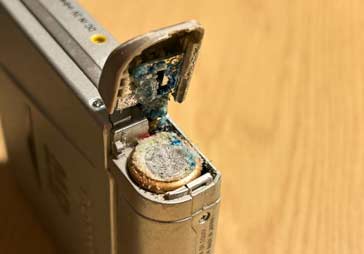Battery Corrosion: The Silent Enemy of Electrical Performance
Corrosion associated with all forms of batteries can destroy not only the battery, but also the equipment around it, so its important to understand how it occurs, how to precent it, and perform remedial action when it has happened.
Home » Electronic components » this page
Battery Technology Includes:
Battery technology overview
Battery definitions & terms
Battery capacity & life
Batteries / cells in series & parallel
Zinc carbon
Alkaline cells
Zinc air cells
Lithium primary battery
NiCad
NiMH
Li-ion
Lead acid
Battery leakage cleaning, cures
Battery corrosion is a common and often overlooked issue that can significantly impact the performance and lifespan of various electronic devices, from vehicles to portable electronics.
When batteries leak, the chemicals inside them cause corrosion to the surrounding mechanics and electronics.
When this happens it is important to be able to know how to repair and recover the equipment, but best of all it's best to be able to prevent it happening in the first place.

Understanding the Culprits: Causes of Battery Corrosion
Battery corrosion is a chemical reaction that occurs when the battery's electrolyte, typically an acidic or alkaline solution, reacts with the surrounding environment or the battery terminals themselves.
Different types of battery use different chemistries and this can affect the way in which any remedial work has to be undertaken.
Battery Chemistry and Corrosion
The specific corrosion mechanisms can vary depending on the battery chemistry:
Zinc-Carbon Batteries: These common household batteries utilize a zinc anode and a carbon cathode. Corrosion often manifests as a white, powdery deposit around the zinc anode, which is the negative terminal. This deposit is primarily zinc chloride, a byproduct of the electrochemical reactions within the battery.
These batteries were very prone to leaking, especially as the charge level reduced. Even though there were some supposedly 'leakproof' batteries, these too would leak after a time.
Alkaline Manganese Dioxide Batteries: These are now the most popular form of primary cell for home electronics and other items. They provide a much longer life than their zinc carbon predecessors.
Despite the fact that many believe these cells do not leak, this is ot the case. They even appear to give off gases which can cause corrosion if they are used in a totally sealed space, such as in the waterproof torches that are very common these days. The terminals in them can become corroded even when the batteries themselves appear to be totally intact.
Corrosion in alkaline batteries can occur particularly at the terminals, often appearing as a greenish or bluish deposit. This is typically due to the formation of copper salts if copper is present in the battery terminals or connections.
Lead-Acid Batteries: Used in automobiles and other vehicles, lead-acid batteries are susceptible to corrosion at the terminals. Sulphuric acid, the electrolyte in these batteries, can react with the lead-based terminals and the surrounding metal components, forming lead sulphate crystals. This corrosion can hinder current flow and reduce battery performance.
Lithium-Ion Batteries: While less prone to terminal corrosion than some other battery chemistries, lithium-ion batteries can experience internal corrosion. This can occur within the battery cells themselves, leading to capacity degradation and potential safety hazards.
Consequences of Battery Corrosion
There are many consequences that occur when batteries leak:
Reduced Battery Performance: Corrosion buildup on the terminals increases electrical resistance, hindering the flow of current. This can result in difficulty starting the engine (in vehicles), reduced battery life, and decreased overall performance of electronic devices.
Electrical System Damage: In vehicles, corrosion can cause electrical shorts, damaging electronic components and potentially causing fires.
Increased Battery Self-Discharge: Corroded terminals can create a pathway for current to leak from the battery, even when the device is not in use, leading to premature battery discharge.
Vehicle Starting Issues: In vehicles, corroded battery terminals can prevent the engine from starting, causing frustration and inconvenience.
Safety Hazards: In some cases, severe corrosion can lead to gas leaks, which can be flammable or even explosive, especially in lead-acid batteries.
Preventing Battery Corrosion
In some ways it is difficult to stop a battery leaking, but there are some things that can be done to minimise the risk of damage to a gadget or system, and also maintain its efficiency.
Some of the steps that can be taken are listed below:
Don't leave batteries in equipment when not in use: One of the most common instances of batteries leaking occurs when the gadget or item that is being powered is left for a length of time without use and with the batteries still in place. Under these circumstances any degradation in performance will not be noticed and the batteries will steadily become more prone to leak.
Regular Inspections: It's not always easy to achieve and remember, but regular inspections of the battery and battery terminals (as these can give the tell-tale signs particularly for lead acid batteries) for signs of corrosion. These may be white, green, or blue powdery deposits, or any general signs of leakage.
Keep Terminals Clean: For batteries like lead acid batteries in particular, clean the terminals and surrounding area regularly with a baking soda and water solution. Avoid using metal brushes, as they can damage the terminals. For stubborn corrosion, you may use a commercial battery terminal cleaner.
Use Battery Terminal Protector: Again, mainly for lead acid batteries, apply a thin layer of petroleum jelly or a battery terminal protector to the clean terminals to prevent corrosion.
Maintain Proper Charging: Ensure the battery is properly charged and avoid overcharging. Use a battery charger with a built-in automatic shutoff feature.
Minimize Parasitic Loads: Disconnect any unnecessary accessories when not in use to minimize parasitic drains on the battery.
Store Batteries Properly: When storing batteries, keep them in a cool, dry place away from extreme temperatures and moisture.
Treating Battery Corrosion
When corrosion occurs around a battery of any description the chemicals that come from the battery will cause corrosion to the fixings and any electrical or electronic equipment around it.
Different types of battery contain different chemicals and therefore need to be treated differently.
However, whatever the battery, it is necessary to take precautions not to come into contact with either the electrolyte or the corrosion - wear protective gloves and clothing and of course it is wise to wear eye protection as well.
Zinc carbon & alkaline manganese cells:
One of the main types encountered in electronic equipment, torches, etc is the zinc carbon and alkaline cells.
As the name indicates, these batteries have an alkaline electrolyte and this governs the way in which any corrosion should be treated.
The main steps for dealing with corrosion from a zinc carbon or alkaline manganese battery are as given below:
Remove battery if possible: It is always best to remove the battery as the first step. This may not always be easy and if it is not possible to remove, then some fo the other stages may need to be undertaken first. Sometimes it may be possoble to remove the battery by drilling a small hole into it and then
Brush deposits away: Brush the deposits away with a gentle brush. An old toothbrush is often ideal. This will remove te excess deposits and enable the next stage to be undertaken more successfully.
Use dilute acid As the leakage from the battery cell is alkaline for this type of battery technology, it is necessary to neutralise it. This is best done with a dilute acid. Lemon juice or diluted vinegar such as white wine vinegar is best, but it should be diluted so that is does not cause further damage.
Use baking soda: Bicarbonate of soda, sodium bicarbonate is a very mild alkali and is sometimes used as the first line of treatment as it is much milder than the alkalis from the batteriers. It can be mixed into a paste and added to the affected areas after the acid.
Clean remaining residues: The final clean should be undertaken using a brush to remove any final residues. It may also be necessary to remove any oxidation from any contacts to ensure good electrical connectivity.
It is necessary to ensure that any electronic circuitry is protected fromt he cleaning process as far as possible. If it has been affected by the battery leakage, then it sould be cleaned carefully otherwise further damage might be caused.
Battery corrosion is a common and preventable issue that can significantly impact the performance and lifespan of batteries.
By understanding the causes of corrosion, implementing preventive measures, and addressing corrosion promptly, you can ensure the longevity and optimal performance of your batteries in various applications.
Regular inspections and proper maintenance are key to minimizing the effects of corrosion and maintaining a healthy battery system.
Disclaimer: This information is for general guidance only. Always refer to the manufacturer's instructions and consult with a qualified technician for specific battery maintenance and repair procedures.
 Written by Ian Poole .
Written by Ian Poole .
Experienced electronics engineer and author.
More Electronic Components:
Batteries
Capacitors
Connectors
ADC
DAC
Diodes
FET
Inductors
Memory types
Phototransistor
Quartz crystals
Relays
Resistors
RF connectors
Switches
Surface mount technology
Thyristor
Transformers
Transistor
Unijunction
Valves / Tubes
Return to Components menu . . .


